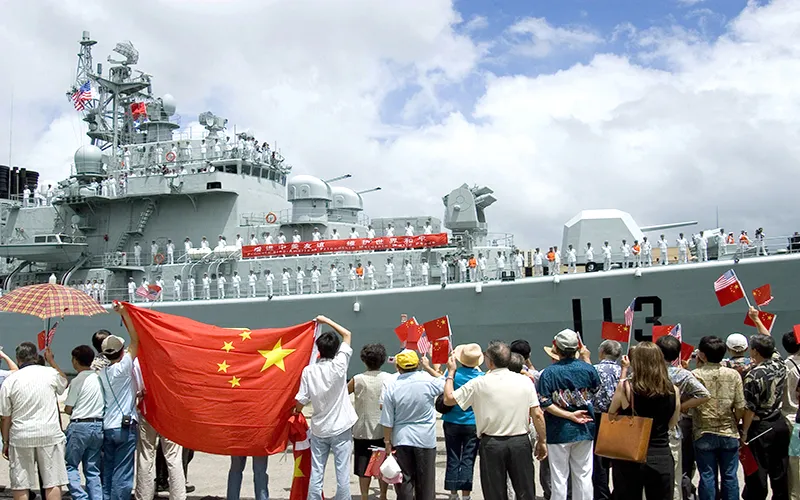-
CENTRES
Progammes & Centres
Location
India will need to tread lightly in its pursuit to be more assertive vis-ナ-vis the Chinese in the IOR. Low key, footprint initiatives, like surveillance stations and docking or berthing rights, may be the key in increasing the reach of its security net in the region, minus the political backlash of acting like a regional hegemon.

When Prime Minister Narendra Modi visited Tajikistan recently, some sections of the media drummed up New Delhi's long pending hope of using the Tajik airbase Ayni. While Mr Modi's trip went by without even a mention of the airbase, India's interest in basing its military overseas to secure its rising strategic interest warrants further exploration.
The Ayni air base was renovated 2002 onwards with the aim of establishing it as India's first Central Asian military outpost. Ayni is now almost never publicly discussed apart from the odd media article when any Government functionaries from India and Tajikistan meet. While Pakistan and China may have had objections to India basing military assets so close to their border, New Delhi's plans were opposed by it's strategic partner, Russia. Moscow does not want foreign powers to deploy fighter aircraft in it's backyard.
Also, how an air base hosting a squadron of helicopters or a handful of fighter aircraft can help New Delhi in securing its resource interests coming through Afghanistan and Pakistan (Turkmenistan, Afghanistan, Pakistan and India pipeline), remains questionable.
Indian aspirations in Central Asia aside, New Delhi has over the last few years set up a number of small overseas military establishments across the Indian Ocean Region and the Gulf of Eden. These are mostly radar stations with a low footprint and do not house military assets or troops which can be used for offensive operations. Apart from in Seychelles, Mauritius, the Maldives, Madagascar and Muscat, there are six Coastal Surveillance Radar Stations based in Sri Lanka.
These radar stations help India monitor ships sailing past these regions, helping the Indian Navy observe the movements of all ships operating in the Indian Ocean. The IOR surveillance project is India's response to China's aggressive new operations in the region.
In 2009, there were reports about India setting up a naval air station in Muscat to help tackle piracy in the region. While nothing has ever been heard about that initiative again, Muscat's proximity to the Chinese-constructed Pakistani port of Gwadar would have reaped huge strategic advantages.
Deploying troops overseas is not a new issue to India. Troops have been sent across the globe on United Nations Peacekeeping Missions. While most of these deployments have not served any strategic purpose other than the altruistic hope of getting a permanent seat on the UN Security Council, this trend has recently changed. India's contribution of troops to the peacekeeping mission in south Sudan is more than an attempt to win favour in the UN, as India has burgeoning economic interests in the country.
China too has deployed 700 combat troops as it has huge stakes in south Sudan oil fields. Making no attempts to hide the primary purpose of these troops, Beijing secured a deal with the UN, where peacekeepers were used to protect south Sudan's oil workers last year. Unconfirmed reports of China setting up a base in Djibouti feed into the narrative of China's willingness to wield a stick in regions where it has commercial interests.
Does India need to pursue a similar strategy to counter-balance the Chinese or secure its interests in the region? There are a number of factors that New Delhi will need to consider if it intends to walk down that road. First, it needs to contextualise basing rights in a broader security relationship with the host country and its security needs. Second, the hosting country's political stance towards Indian military presence has to be considered. Larger bases with foreign troops have historically evoked domestic opposition. The lack of opposition so far to small Indian deployments like the like radar stations can be linked to indifference or acceptance.
Both China and India are competing to secure the sea lanes in the IOR. This competition encompasses everything from docking rights for commercial shipping to naval patrols to anti-piracy operations. Now this rivalry has spilled into Africa.
India will need to tread lightly in its pursuit to be more assertive vis-à-vis the Chinese in the IOR. Low key, footprint initiatives, like surveillance stations and docking or berthing rights, may be the key in increasing the reach of its security net in the region, minus the political backlash of acting like a regional hegemon.
(The writer is a researcher at Observer Research Foundation, Delhi)
Courtesy: The Pioneer, July 20, 2015
The views expressed above belong to the author(s). ORF research and analyses now available on Telegram! Click here to access our curated content — blogs, longforms and interviews.

Pushan was Head of Forums at ORF. He was also the coordinator of Raisina Dialogue. His research interests are Indian foreign and security policies.
Read More +